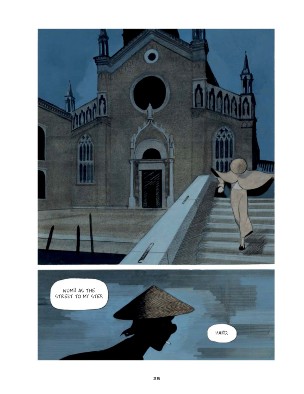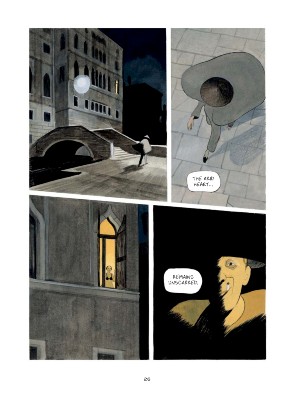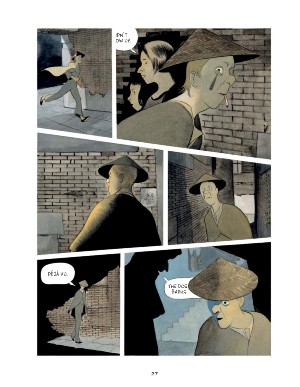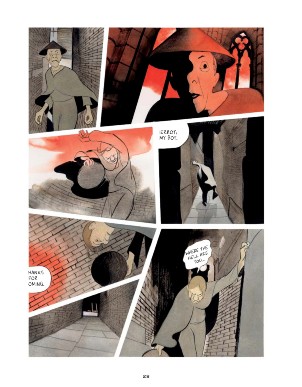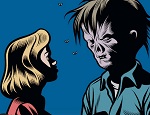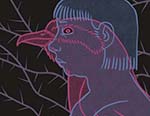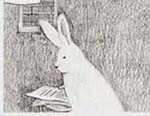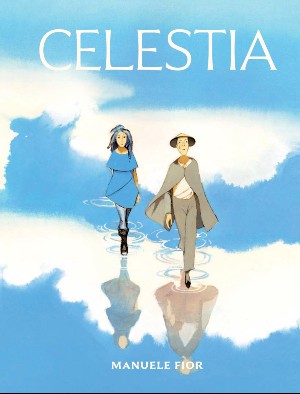 Celestia, the latest graphic narrative from Manuele Fior, immerses readers in a vast and ethereal dreamscape of the future, where complex interpersonal dynamics are one of many aspects to simultaneously entice and evade comprehension; yet, in a realm where telepaths can enter dreams and memories can be read aloud like poetry, these mere glimpses and hints of deeper narratives simply reinforce its mysticality.
Celestia, the latest graphic narrative from Manuele Fior, immerses readers in a vast and ethereal dreamscape of the future, where complex interpersonal dynamics are one of many aspects to simultaneously entice and evade comprehension; yet, in a realm where telepaths can enter dreams and memories can be read aloud like poetry, these mere glimpses and hints of deeper narratives simply reinforce its mysticality.
These glimpses are offered up to us through Celestia’s unique and delicate artwork. By often only allowing us to see glimpses of the action, profiles or silhouettes of faces, or selective portions of the scenery not covered in inky shadow, Fior is forcing us to lean in closer to decipher the world of Celestia. However, this is made even harder by the restrictive angles and constant perspective shifts which disorientate and delineate the narrative flow; panel borders slice through the action making us always feel as if something is just out of sight. This contributes to the general foreboding that is itself reminisce of the omnipresent threat experienced in nightmares.
Strong black ink works to isolate and dislocate images, adding a surreal ‘otherness’ to them in the process, as well as an implied significance that tempts us to read further. At the same time, the lightness of the brush strokes and pencil lines adds a softness to the page. Most scenes have two distinct tones, dividing episodes and setting a clear mood, whilst also showing the shifts in pace and transitions of time. These are very much needed given the disjointed narrative style, allowing us to grasp onto some linear progression as we delve deeper into Fior’s fantasy.
The medium takes dominance as drama escalates, with the paint strokes getting bigger and bolder and less defined. This conjoined escalation, of action and the imagined speed and force of the artist’s hand at work on the page, adds a certain self-awareness; we cannot forget there is a mind at work unravelling the story for us in a very intentional way. Yet, the nature of the ungraspable intentions of characters themselves gives Celestia a definite Existentialist overtone. The reader must make for themselves Kierkegaard’s ‘leap of faith’ – the idea that there are no rules to guide us so we must renounce reason – as they continue to invest in the story without really knowing what is happening, and even witness a literal ‘leap of faith’ in a scene where our characters must make a rapid escape. Although, this need to escape is also a very prominent theme throughout, and acts as the impetus for most of these defined episodes of action – again, similar to that driving force that takes over us when submerged in a bad dream.
Meanwhile, our main character Pierrot acts as a disillusioned protagonist. For example, by referring to everyone else as “You people” he marks himself as separate to everyone else. Although perhaps simply self-entitled and arrogant, his personality remains mysterious – like everything else in this narrative. He always looks so grumpy, as if he is begrudging enduring the adventure enforced upon him and has simply submitted himself to the absurdity of his existence. Additionally, the make-up beneath his right eye, depicting a black tear drop, can be seen as an intentional mockery of the emotions of others. Pierrot appears to suppose the emotions others experience are nonsensical in the face of the irrationality and absurdity of the world around them.
As well as inviting the reader to embark on a journey into the mind of Fior, Celestia is also a commentary on the art form itself. For example, there is a moment when we are zoomed in on a work of art, but we do not realise it is a framed picture within the narrative until the panels allow us to step back and see this is just a part of the background art. Again, this acts as another disorientating technique that ensures the reader remains at an arm’s length from any distinguishable storyline, allowing Celestia to better replicate the sort of disjointed narrative one experiences within dreams.
Being necessarily ungraspable, we are always aware of Celestia as a work of art, as a creation of Fior’s imagination, and this allows for a greater appreciation of the tactile skills involved, and for each panel to be seen in their own right – as individual works of art.
Manuele Fior (W/A), Jamie Richards (T) • Fantagraphics Books, $29.99
Review by Rebecca Burke





